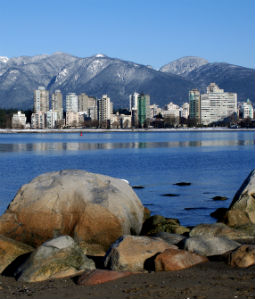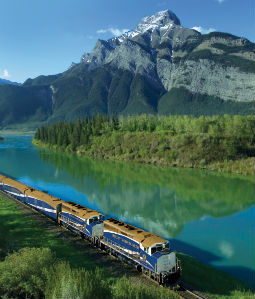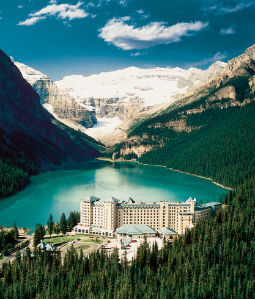Aug 31, 2017 by Susan Gough-Henley
I took up from my lunch of wild British Columbia salmon and Okanagan Merlot. Just outside the train window is an elegantly engineered beaver pond reflecting sheer snow-covered mountains. This is way better than David Attenborough on the wide screen.I am on the inaugural 25th anniversary journey of the multi-award-winning Rocky Mountaineer train, a daylight-only train adventure that offers sensational itineraries through the Canadian Rockies. It comes from a proud pedigree of two great railways, the Canadian Pacific and Canadian National Rail, which played key roles in the settlement of Canada.
The president of Canadian Pacific Rail believed tourism was vital to the railway’s success and he famously said back in the 1880s, “If we can’t export the scenery, we’ll import the tourists”. Import them they did, with both companies developing grand hotels to entice travellers along their routes. More than 130 years later Rocky Mountaineer GoldLeaf guests still stay in spiffed-up, Victorian-era edifices like the Banff Springs Hotel, Chateau Lake Louise and Jasper Park Lodge, all run by the Canadian hotelier Fairmont.

We board the sleek navy and gold train at Rocky Mountaineer’s station in Vancouver. “Welcome aboard the most spectacular train trip in the world,” booms Tyler, the guest services manager, as we settle into a luxury two-storey GoldLeaf carriage for the two-day Journey Through the Clouds route to Jasper. As the train pulls out of the station, I peruse my surroundings. I’m seated upstairs in a custom-heated, reclining, leather seat under a glass dome, designed to allow guests to better enjoy the mind-blowing views. An elegant, white-tablecloth dining room is downstairs, along with a covered outdoor viewing deck.
“If we can’t export the scenery, we’ll import the tourists”.
Each carriage in GoldLeaf has two meal services for breakfast and lunch. Those on second service feast on fresh scones and coffee as they wait for breakfast, and wine and cheese before lunch. The order is reversed on the second day so everyone can enjoy being second! By the time I’m tucking into fluffy pancakes with Canadian maple syrup (when in Rome, after all).
I note that the river is now a churning chasm of glacial melt beside the train tracks. At Hell’s Gate, we learn that two hundred million gallons of water surge every minute through the narrowest point of the river. No surprise that Fraser carried his canoes along the canyon walls. saying: “This was a place no human being should venture, for surely we have encountered the gates of hell”.

Bernardo, our Rocky Mountaineer host, is sure to tell us the story before the photo opportunity, when the conductor slows the train so we have plenty of time to grab our cameras and head to the outdoor viewing area for the perfect shot. The rush of cold mountain air soon forces us back inside for another hot cuppa. As we cross to the other side of Jackass Mountain, the landscape changes into a semi-arid desert. I had no idea that British Columbia could be so dry. Outside our window is the Jaws of Death Gorge, a popular rafting spot. Bernardo, only half-jokingly, describes these rapids as being 64 on “the washing-machine scale” of rafting difficulty, when normal rafting protocols state level six is the most dangerous. He points out the Cheese Grater and Witch’s Cauldron, which are surpassed in fear factor only by the aptly-named Mother-in-Law rapids.
Soon we are marvelling at clouds reflected in the mirror-like Kamloops Lake before the train eases into Kamloops station, where red-shirted cowboys on horseback welcome us. Our apartment hotel is near the train tracks and, after freshening up, we enjoy exploring this gateway to the ski slopes and the Okanagan wine region, by stopping for microbrews at the Noble Pig Brewhouse and a terrific upmarket meal at Terra Restaurant.
“Cloudy with a chance of bears”
On board for our second day, Bernardo welcomes us with the weather report: “Cloudy with a chance of bears”. Sadly, it rains most of the day, but this has little impact on our wildlife spotting. First we see big horn sheep beside a lake, then a young black bear frolicking in the woods.
I take the opportunity to walk around the spacious cabin to chat with neighbours, many of whom hail from Australia and New Zealand. One couple had even been on the first Rocky Mountaineer trip 25 years ago. Bernardo gives us plenty of notice to get ready to photograph the spectacular Pyramid Falls, which plunges 100m beside the train to the Thompson River below. He tells us about the river’s namesake, David Thompson, one of the greatest land geographers of all time, who mapped almost four million square kilometres of Canada, much of it in the Rockies, with little more than a sextant and a telescope.
Straight ahead is the imposing striated profile of 3954-metre Mount Robson, the highest peak in the Canadian Rockies. It’s easy to see why mountain climbers nickname her the Great White Fright. “Moose at 9 o’clock,” says Bernardo excitedly, not far from the aptly named Moose Lake and I almost fall over my Made-for-a-Mountie Burger in the rush to photograph not one but two moose – one of the rarest of animals to spot in the Canadian wild.
Jasper and the Icefields Parkway
Our train journey draws to a close at the historic station in Jasper, but there is still that destination and its grand hotels to enjoy.
Jasper Park Lodge, on the shores of turquoise Lac Beauvert, exudes everything you’d imagine a classic Canadian Rockies lodge to be: moose antlers atop soaring stone fireplaces, log cabins adorned with fly-fishing rods, canoes at the ready, and colourful lawn chairs perfectly placed for mountain gazing.
I’ve opted to add on a goose-bump-inducing bus trip along the Icefields Parkway, one of the world’s most spectacular drives, all the way to Banff. I press my face to the window for the entire journey to soak up mile upon mile of mountain scenery. There’s even time to explore the powerful Athabasca Falls and take a giant Ice Explorer bus up to the edge of the enormous Columbia Icefield to walk on the Athabasca Glacier.

We stop at Chateau Lake Louise, resplendent in picture-postcard glory on its emerald lake. But for me, the grand Scottish baronial Banff Springs Hotel is the perfect Rocky Mountaineer finale. I imagine kilt-wearing railway entrepreneurs deciding that a Scottish castle with stone turrets would be the perfect vantage point to admire those awe-inspiring peaks. And if I squint I might just see another beaver dam since, thankfully, however, top hats are no longer in fashion.
